
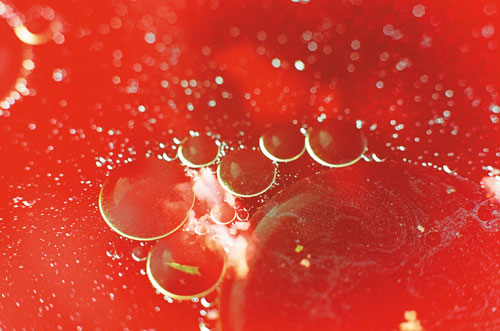

Carnality of Nature. On the Photography of Paweł Maciak.
In the tradition of European painting images of food - this colonized element of Nature, adapted to fulfill the practical needs of man - were usually pushed to the margin of "true", significant art whose "knowledge horizon" reached far beyond the sphere of human existence. In this respect the work of Dutch artists of the 17th century seems exceptional, because they made still life the Muse of their artistic explorations. Their works also at least partly revived genre painting which was rejected by the then dominating form of culture. Images of fruits, vegetables, meat or flowers in the works of Dutch masters carried deeper, symbolic meanings behind the screen of easily observed allusions, but they also celebrated "consumption"of happiness resulting from the sensual experience of life and its many physical pleasures.
"We grow plants and breed animals. We do it to meet our material, aesthetic or spiritual needs. In human culture which is connected to nature we attribute aesthetic values to house plants as well as to eating meat. At the same time many animals and plants may be symbols of existence for us - or they can even become friends in our everyday life"2. As the author rightly observes the world of the fauna and flora in human consciousness may cover a large spectrum of hierarchy: from the basic, utilitarian function like feeding, through a substitute for a fellow human being to causing visual pleasure. However, not every work of Nature can be honoured by being raised above Its other manifestations. So it is not hard to understand the aesthetic adoration that surrounds a rose, for example. It not only seduces the viewer with its strictly formal charms - like delicate pedals, baroque lusciousness of the calyx and saturated colours - but also with the sweet, intoxicating scent. The rose is the giver of sensual pleasures and it exists only in order to be admired without putting it to any pragmatic use. Due to its devastating looks we have attributed to it in our cultural discourse also certain symbolism that points to the rose’s spiritual dimension. Why have not cabbage or the cauliflower become objects of equally ecstatic tributes? Are they not adorned in an equally attractive and expressive form? A partial answer may be the brutal distinction into the sphere of spirituality (moral values) and carnality, much celebrated in western European culture and identified with the most primitive and primal animality. From this perspective, representations of food in art deserved contempt because they immediately brought to mind allusions to the vision of the eternally chewing, incomprehensible, biological Moloch, full of disgusting fluids (like saliva and digestive juices), whose image was completely different from the idealized beauty of the body without "carnality", conceived in the ancient tradition. An eating man thus becomes just a kind of animality, a kind of meatiness, subverting the order of culture that makes him human. Such veristic, not stylized commercially images of food are visually unwanted and dangerous, as they remind us of the human "beast", hiding just below the surface of manners and civilization and programmed to tear apart and devour other living things.
Paweł Maciak’s macrophotographs from the series called Energy (What I Eat) are an attempt at presenting a specifically conceived "internal life" of the foods we eat every day. Big blow-ups and close-ups of fluids with "eyes" of soup fat simultaneously authenticate and make this seemingly clearly defined observation of a trivialized reality unreal. They become concrete thanks to the close concentration on the studied object, but then break all ties with reality - which is too easy to visualize - because the represented elements have been isolated from the rest of the imagery. Paradoxically the final effect is a wholly realistic, no to say documentary, photograph, whose content remains enigmatic and cannot be deciphered without a key - which is the knowledge of what is represented in it. Looking for the best way to reach the other dimension of the truth of the world around us, the artist - in a sense rather irrationally - drifts into mysterious regions of abstraction. Food shown fragmentarily and in big close-ups becomes illegible and hard to recognize. These photographs have an evidently plastic, painting-like ability to create unusual structures, rich in dynamic, relief-like planes of "cosmic landscapes". A fragment of a bone sticking out above the foaming surface of a fluid brings to mind rocks washed by the waves of a a stormy ocean. The author seems to be fascinated by the discovery of aesthetic possibilities inherent in the materiality of pieces of meat or in a heavy, thick broth - and he meticulously shows us details, like fantastic patterns of the tiny bits of fat on the surface, the architecture and texture of given substances. On the other hand, his photos are unusually "carnal"; they explode with the accumulated, internal energy of metabolical change and visibly mark their physical or even physiological presence which disturbs the dead flatness of a photograph. They bring to mind illustrations from a medical handbook - explorations in fascinating, hitherto unknown nooks and crannies of the human organism. They restore lost unity of man and Nature and show our biological side as one of the manifestations of Nature’s Demiurge-like activity.
The most recent series of pictures entitled Energy in Pictures is formally much different from its predecessor, though Maciak again points his camera at foodstuffs and makes their ingredients main heroes of his photographic stories. This time, however, we can have a good look at and guess the "identity" of a given product, as blow-ups do not impede notional identification. As far as the composition goes we can see the switch from analytical to synthetic attitude, which is analogous to the cubist way of representing reality: we proceed from the dispersion of the whole entity into ever smaller elements to the restoration of a unified, autonomous construction. The artist tried to depict the individual character of each of the objects isolating them on purpose, selecting them in every photograph as autonomous entities and looking at them closely, in great detail. Thus Maciak portrays certain individual aspects of the biosphere as if he were working with a human model - trying to find the quality of originality and uniqueness of the given example of Nature in the face of universal commonness of repeatable forms and certain structures (as having eyes, lips, a nose or ears among human beings). However, these are not images that give pleasure to the eye by means of causing some visual sensations or idyllic sets of structures and colours. Their aesthetic value can be perversely discovered in the defects and rawness of the tissue of the photographed objects. Therefore it is a kind of depreciated beauty which feeds on specific, turpist sensitivity. These and earlier photographic series by Maciak function in the sphere of a certain taboo and their biological intimacy sometimes causes embarrassment, giving us the illusion of participation in an immoral (because reaching the deepest levels of carnality with all its physiological debauchery ), hermetic ritual of fertility. The stickiness of the watery soup, the wet, shining and slippery consistency of fats or meat tissues, the meatiness of fruits dipped in dough, as well as the cracked and fractured surface of a cream cake, resembling the wrinkled skin of an old man, all convey a threatening feeling of danger and growing lack of comfort. These elements, whose presence has been accentuated on the plane of the photograph thanks to the use of dramatic, contrasting lighting, additionally intensify the state of nervous anxiousness. The works of Paweł Maciak give us perverse, sensual pleasure which is just a step away from masochistic, visual self-torture.
1 „Ordinary beauty" that Paweł Maciak wrote about in one of his texts: „Beauty does not run from reality. Our opinion of it is disinterested".
2 P. Maciak, Zwyczajne piękno [Ordinary Beauty], authorial text, 2004.
Eva Milczarek
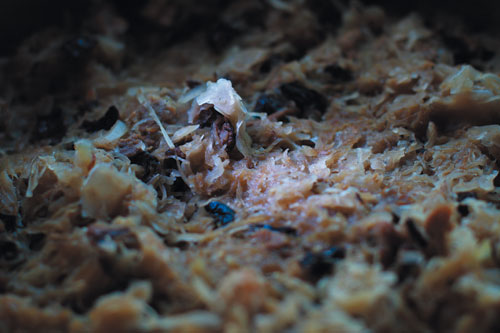
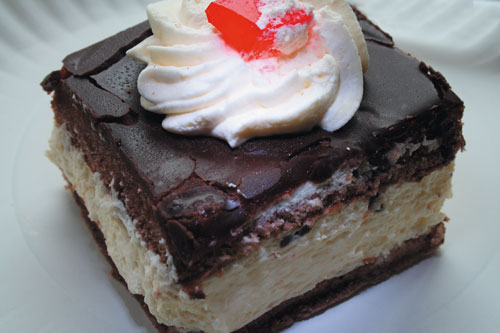
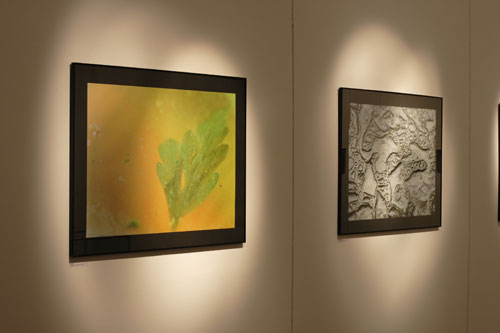
View from exhibition
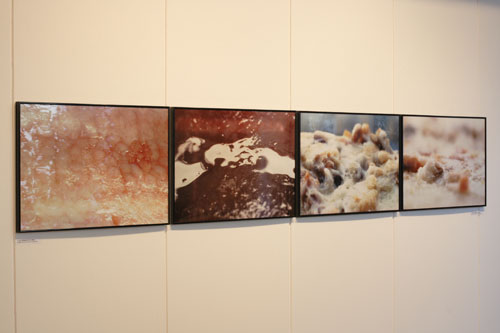
View from exhibition
Next exhibition
1.02.2008
Copyright ©2008 Galeria FF ŁDK, Paweł Maciak, Eva Milczarek